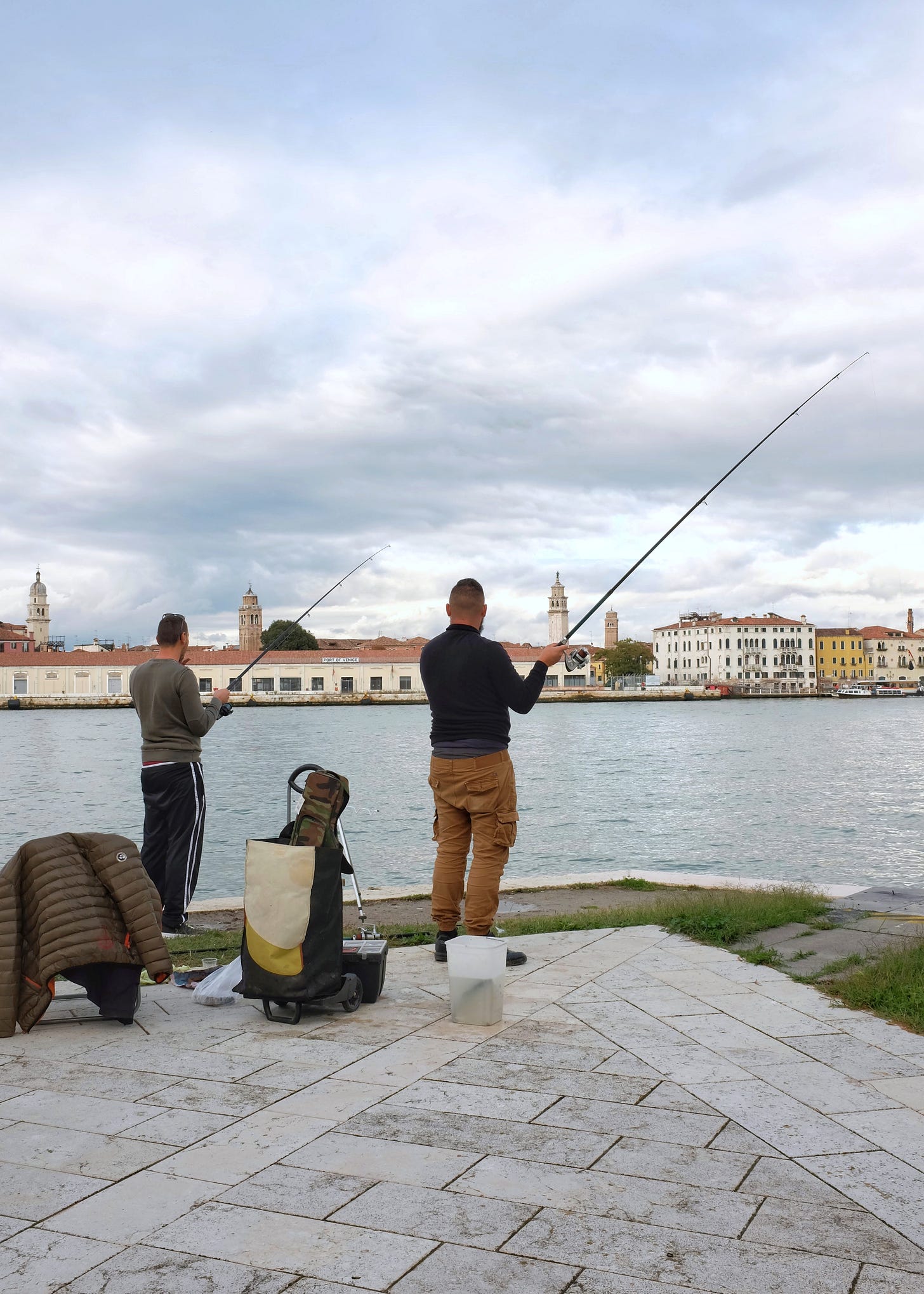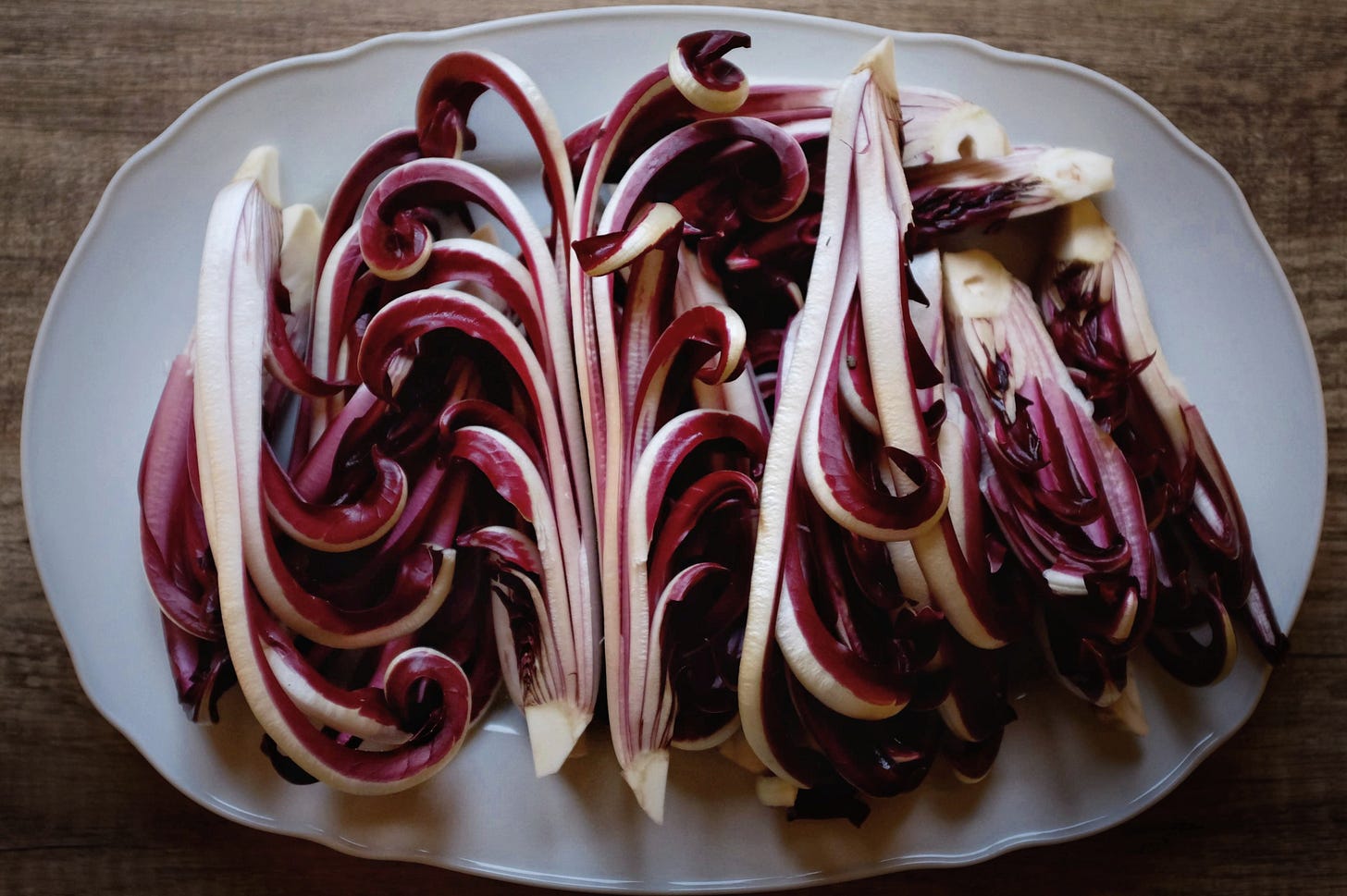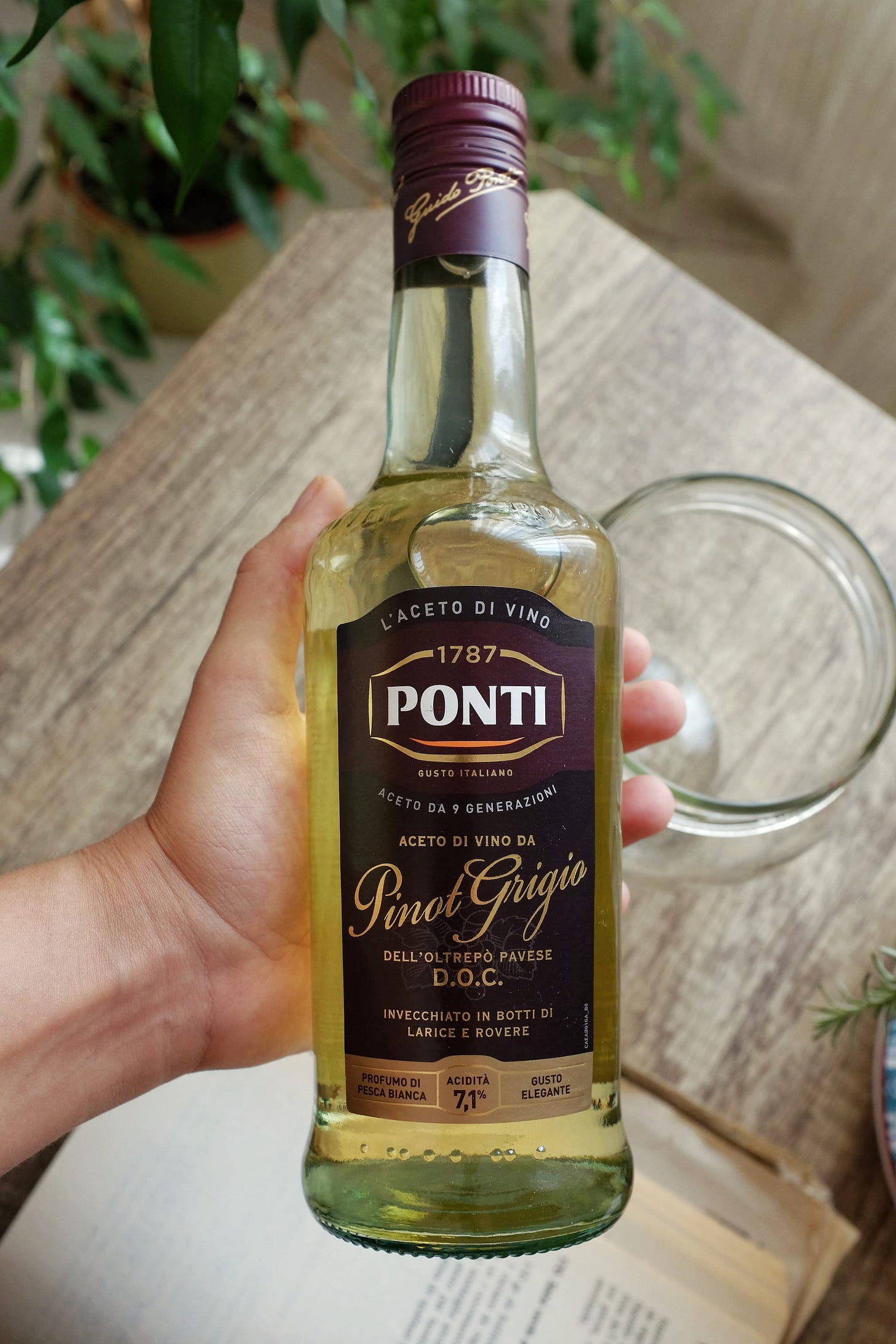Hi, you're reading Dash of Prosecco, a newsletter about good food, slow travel and life on the mainland of Venice. If you haven't subscribed yet, you can click the button below, and if you enjoy this publication you can share it with whoever you like. I'm glad you're here.
A Year of Seasonal Eating (part 1)
There are two major forces in my life: cabbage in winter and my mother-in-law all year long.
Every week, my partner's mom Anna receives a dm from her “veggie dealer”, asking what she’d like. A few seconds later, photographs of the freshest produce start flooding my phone, followed by the familiar: “What should I get you, guys?” To which I usually reply: “We’ll get the same as you!” And so she orders what’s in season... for all of us.
In winter, this means a truckload of cabbage and a few other knobbly vegetables and fruit from the local countryside: delica pumpkins, long leeks, earth-smudged spuds and, on special occasions, a few noble bunches of radicchio tardivo di Treviso.
For those of you who don’t know, the crunchy blooms of the radicchio tardivo are one of the reasons why winter feels special here.
Probably the most prized seasonal delicacy of the colder months, the tardivo is a forced, late-harvest variety of Italian chicory that’s native to Treviso, a pretty town north of Venice.
It’s easy to spot at the market becauseit's such a good looker: sensual, high contrast leaves that end in a head of dainty curls.
But there's more to it than a fabulous aesthetic.
Raw tardivo feels refreshing and sweet in the mouth, like a sip of spring water, making it a wonderful cleansing salad for a thirsty guest. When cooked (think risotto and lasagna), things start to change. The brightness is lost to a subtle, smooth earthiness, while the texture, once crisp, becomes slippery and sort-of an acquired taste.
Cooked or raw, the tardivo brings a certain festive excitement to the table, so if you feel like splurging, Christmas is a good time to buy a few bunches (see recipe at the end of the post for a very good tardivo starter idea).
Sweet & Sour “Saor” with Radicchio
At home, we eat radicchio tardivo in several ways. I love it in a simple, crunchy salad with wine vinegar, salt and black pepper; and in a tomato-less lasagna with walnuts, gorgonzola and goat milk béchamel.
However, my all-time favourite radicchio dish - and one that I pull off for special occasions, is“saor”.
Venetian people love their saor. Be it summer or winter, they most enjoy this sweet-and-sour preparation when there’s something to celebrate (so much so that over the centuries, it’s become the flagship dish of one of the major events of the year, the Redentore feast in July).
Saor, which means both “sauce” and “flavour”, is in fact a very flavourful sauce of tender-stewed onions and white wine vinegar. Like any sauce, it’s born out of a desire to improve or change something by bathing it something else. In this case, the intention was simple and practical: to preserve fish onboard boats, while sailors and merchants were at sea. The sweet onions would satisfy the palate, while the vinegar preserved the scaly catch during the voyage.
Still today, when asked about saor, any Venetians will inevitably point to the traditional fish-based version with fried sardines. But saor has a versatile soul and, at the end of the day, it’s a very simple way to add a little pzazz to fish and vegetables, transforming them into juicy “cicchetti”- a small something to eat between meals alongside a glass of wine or spritz - or starters.
Like many preparations from the Italian tradition of cucina povera (poor man’s food), only a handful of cheap ingredients are required: onions, vinegar, fish, salt and pepper. Richer versions may include raisins, pine nuts1 and white wine. I like to use laurel and cloves, too.
There's no one standard way to make saor, really; each family and restaurant have their own recipe. The old cookbook that I’m translating2 from the local dialect lists at least three saor methods: a “classic” version, a variant of it, and an “old fashion” one from the neighbouring town of Treviso.
Below, you'll find my recipe for radicchio “in saor” with key tips to nail this incredible dish.
Think long, dark red curls bathed in sweet-and-sour juices, soft-stewed onions, plump raisins, and creamy pine nuts. You’ll love it!
(For the “classic” version of saor with sardines, translated directly from the book I mentioned above, see this footnote.3)
RECIPE: Sweet-and-Sour Radicchio Tardivo di Treviso (radicchio “in saor”)
Saor and radicchio tardivo di Treviso are emblematic pieces of the delicious puzzle that is Venetian cuisine. My variation adapts the classic fish-based Venetian saor for radicchio, offering a modern vegetarian twist. This juicy, sweet-and-sour starter goes well with good white wine, good bread, good friends.
Requires 12-24 hours rest in the fridge.
Enough for three as an entrée.
Ingredients
300g radicchio tardivo di Treviso
30ml extra virgin olive oil + some for baking the radicchio
300g white onions
90ml good quality white wine vinegar + extra to taste
1 bay leaf, fresh or dried
4 cloves
pinch of salt
twist of pepper
handful of raisins
handful of pine nuts
Method
Prepare the radicchio: Quarter the radicchio, leaving a small part of the fibrous base intact to hold the leaves together. Wash and pat dry. Place on a baking tray, drizzle with olive oil, and season with salt and pepper. Bake at 200°C (400°F) for 10 minutes. The radicchio will soften, lose some colour, and reduce in volume while retaining some bite. Allow to cool, then transfer to a smaller container to prepare for layering with the saor.
Prepare the saor (onion mixture): Thinly slice the onions. Heat olive oil in a wide, heavy pan over medium-low heat. Add the onions, bay leaf, and cloves. Cook gently until the onions are soft, sweet and translucent, stirring to prevent burning (about 20-30 minutes). Add the white wine vinegar, cover with a lid, and continue cooking on low heat until the onions are fully tender. If needed, add small amounts of water, white wine, or vinegar to keep the mixture juicy. Adjust the vinegar to taste, ensuring the flavor isn’t overpowering.
Assemble the dish: Season the saor with salt and pepper. Stir in the raisins, encouraging them to soak up some juices. Sprinkle the pine nuts evenly over the cooked radicchio. Spoon the saor generously on top, making sure it covers the radicchio leaves and seeps between the layers.
Rest and serve: Leave the dish to rest in the fridge for 12 to 24 hours so that the flavours meld. Serve at room temperature. Do not reheat.
Tips For a Fantastic Saor
Perfect saor is all about balance—sweet onions, high-quality vinegar, and a well-prepared main ingredient (your fish or vegetable of choice). Follow these tips for the best result:
Use the highest-quality ingredients you can find: This is a very simple recipe, comprising just a few elements and simple techniques, making the quality of ingredients of paramount importance.
Pick the right onions and vinegar: the sweet-and-sour balance of saor relies heavily on the onions and vinegar. In Venice, we use a specific type of onion that is grown in the sandy fields of the lagoon town called Chioggia. It's round, white, naturally sugary and unlikely to be available outside the Veneto region. To replicate this dish, pick the sweetest variety of onion you can find, best if yellow or white, but if all you can find is red, go ahead. The vinegar should be made from white wine, and high quality, too. Cheap vinegar will be too sour and overpowering, while good vinegar provides the right amount of tang and imparts a welcome mellowness. I use Ponti’s Pinot Grigio vinegar with an acidity of 7,1%. It’s much better than the cheaper options and available in any Italian supermarkets.
Pick the right main ingredient: If making a vegetarian saor, as with my recipe above, remember that produce, must veer towards the sweet side. For radicchio saor, this means picking the tardivo variety over other radicchios, which tend to be quite bitter. Alternatively, a delica pumpkin (roasted) in autumn or a very fresh eggplant (grilled) in summer will give you a wonderful result for a much more affordable price when compared to the tardivo. As a vegetarian, I’m not the most qualified person to provide guidance on traditional fish-based saor, but, if you’re into fish and seafood, then the two most popular versions would be fried sardines or prawns (mazzancolle).
Use onions and the main ingredient in equal amounts: a 1:1 ratio, weighed raw; when in doubt, use more onions than needed - any surplus can be used for a cheese platter, burger night, or crostini topping.
Don’t let the onions burn: the onions should stew slowly until buttery soft and translucent - no burned bits. Reaching the right consistency could take up to an hour’s cooking, stirring frequently.
Adjust the level of juiciness and sourness: no one likes a saor that's too sour or too dry. Adjust as you go by adding either vinegar, white wine or water while the onions are stewing. Taste test often.
Fish needs frying, but vegetables may not: if you’re making the traditional sarde in saor (saor with sardines) then you’ll have to fry the fish, there’s no other way around it. When subbing for veggies, however, each produce requires its own technique. Fried, grilled, steamed, baked... it’s all good, provided that your main ingredient holds its shape, and the cooking process enhances its sweetness. For example, with radicchio tardivo I only roast it for 10 minutes in the oven because overcooked or fried radicchio loses its sweetness. It also becomes mushy, a consistency that doesn’t compliment this dish at all. Fried eggplants could do for some, but they are too oily for me, so I prefer grilling them in thick slices. Another great option is the delica pumpkin (or any other sweet pumpkin/squash). I roast it sliced but with the skin on so that it doesn’t collapse. Overcooked vegetables in general are not ideal here, as you still want to create a bit of a contrast with different textures.
I hope these tips will help you nail saor, while also giving you the freedom to have fun with your local ingredients! For any questions, drop me a comment below :)
Happy cooking,
Sinù xx
About Me
My name is Sinù Fogarizzu and I’m a vegetarian food writer from the mainland of Venice, Italy. In 2021, I launched Dash of Prosecco, a Substack newsletter about good food, Venetian cuisine and slow travel. Come say hi on Instagram.
A Tola Co I Nostri Veci: Book from the 1970s collecting traditional recipes from Venice and the Veneto region. Everyone knows it, no one cooks from it. It’s written in the local dialect and there is no Italian nor English version available to date (as far as I know). I wrote more about it here.
Sardines “in saor” (classic recipe) - Original title: Sardele in «saor» (ricetta classica) from “A Tola Co I Nostri Veci, La Cucina Veneziana” by Mariù Salvatori De Zuliani. “Clean 1 Kg of large sardines; behead, flour and fry them in oil until they’re half done. On the side, lightly fry plenty of onions, that you’ll have cut into thin slices, using the remaining oil from the fish (the onion must abound because, afterwards, you’ll need enough of it to cover all of the sardines to keep them “in saor”); when the onions are golden, pour over them 1/2 litre of white wine vinegar and 1/4 white wine. Add also 30 gr of pine nuts, 30 gr of raisins, salt and pepper. When the mixture starts boiling, tip it onto the half-done sardines (which you’ll have laid into a wide and shallow casserole) and put it all back on the fire for a few minutes, until the sardines are done. Sardines “in saor” are to be eaten cold, the day after they are made. Sardines in saor, and soles in saor, too, make for a dish that Venetians bring with them on their boats for the dinner of the “Redentor” night. And remember that, it is customary in Venice to add raisins and pine nuts to saor only in winter, to raise the calorie content. In summer, instead, this is not needed!” (Translation by Sinù Fogarizzu from Venetian dialect)













Comments galore. Ha! I'm a cabbage in the winter girl, too. Local produce and markets...totally influential in my culinary journey. These pictures of radicchio are divine!
This process of making soar onboard as a preservation process is interesting. The Japanese have a similar process called surimi which serves as the base of imitation crab. If you're interested, I wrote about last year: https://borschtforbreakfast.substack.com/p/12-tender-is-the-summer-salad